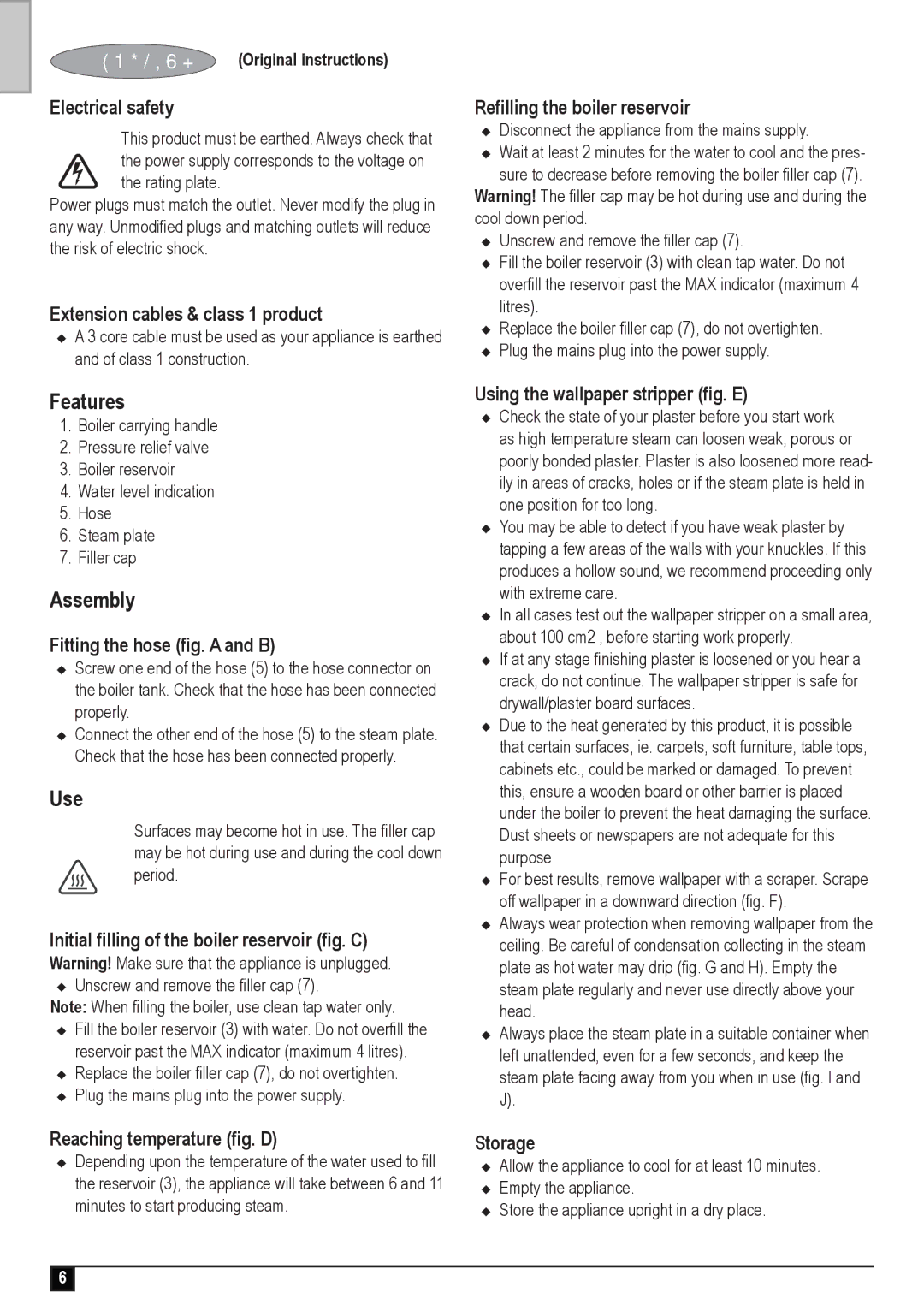
ENGLISH (Original instructions)
Electrical safety
This product must be earthed. Always check that the power supply corresponds to the voltage on
the rating plate.
Power plugs must match the outlet. Never modify the plug in any way. Unmodified plugs and matching outlets will reduce the risk of electric shock.
Extension cables & class 1 product
uA 3 core cable must be used as your appliance is earthed and of class 1 construction.
Features
1.Boiler carrying handle
2.Pressure relief valve
3.Boiler reservoir
4.Water level indication
5.Hose
6.Steam plate
7.Filler cap
Assembly
Fitting the hose (fig. A and B)
uScrew one end of the hose (5) to the hose connector on the boiler tank. Check that the hose has been connected properly.
uConnect the other end of the hose (5) to the steam plate. Check that the hose has been connected properly.
Use
Surfaces may become hot in use. The filler cap may be hot during use and during the cool down period.
Initial filling of the boiler reservoir (fig. C)
Warning! Make sure that the appliance is unplugged.
uUnscrew and remove the filler cap (7).
Note: When filling the boiler, use clean tap water only.
uFill the boiler reservoir (3) with water. Do not overfill the reservoir past the MAX indicator (maximum 4 litres).
uReplace the boiler filler cap (7), do not overtighten.
uPlug the mains plug into the power supply.
Reaching temperature (fig. D)
uDepending upon the temperature of the water used to fill the reservoir (3), the appliance will take between 6 and 11 minutes to start producing steam.
Refilling the boiler reservoir
uDisconnect the appliance from the mains supply.
uWait at least 2 minutes for the water to cool and the pres- sure to decrease before removing the boiler filler cap (7).
Warning! The filler cap may be hot during use and during the cool down period.
uUnscrew and remove the filler cap (7).
uFill the boiler reservoir (3) with clean tap water. Do not overfill the reservoir past the MAX indicator (maximum 4 litres).
uReplace the boiler filler cap (7), do not overtighten.
uPlug the mains plug into the power supply.
Using the wallpaper stripper (fig. E)
uCheck the state of your plaster before you start work as high temperature steam can loosen weak, porous or poorly bonded plaster. Plaster is also loosened more read- ily in areas of cracks, holes or if the steam plate is held in one position for too long.
uYou may be able to detect if you have weak plaster by tapping a few areas of the walls with your knuckles. If this produces a hollow sound, we recommend proceeding only with extreme care.
uIn all cases test out the wallpaper stripper on a small area, about 100 cm2 , before starting work properly.
uIf at any stage finishing plaster is loosened or you hear a crack, do not continue. The wallpaper stripper is safe for drywall/plaster board surfaces.
uDue to the heat generated by this product, it is possible that certain surfaces, ie. carpets, soft furniture, table tops, cabinets etc., could be marked or damaged. To prevent this, ensure a wooden board or other barrier is placed under the boiler to prevent the heat damaging the surface. Dust sheets or newspapers are not adequate for this purpose.
uFor best results, remove wallpaper with a scraper. Scrape off wallpaper in a downward direction (fig. F).
uAlways wear protection when removing wallpaper from the ceiling. Be careful of condensation collecting in the steam plate as hot water may drip (fig. G and H). Empty the steam plate regularly and never use directly above your head.
uAlways place the steam plate in a suitable container when left unattended, even for a few seconds, and keep the steam plate facing away from you when in use (fig. I and J).
Storage
uAllow the appliance to cool for at least 10 minutes.
uEmpty the appliance.
uStore the appliance upright in a dry place.
6
